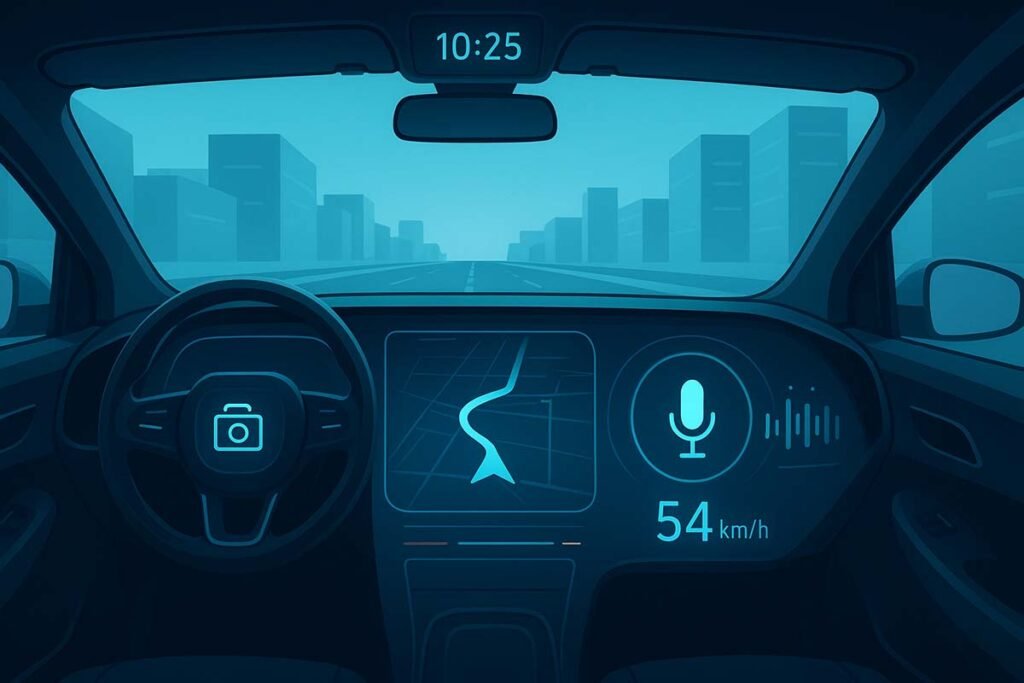Imagine a world where technology can see, listen, read, and even “sense” your needs—all at once. Welcome to 2025, where multimodal artificial intelligence (AI) is turning this vision into reality by fusing sight, sound, language, and even contextual awareness to reshape not just gadgets, but how we live, work, and interact each day.
Traditional AI relied on single data streams: it could read text, or identify images, or answer spoken questions. But multimodal AI blends multiple types of data—images, audio, text, video—to build a richer, “human-like” understanding of the world. This shift makes our devices smarter, our services more personalized, and our everyday experiences more seamless than ever before.
So, what does this mean for families, doctors, consumers, and businesses in the United States? Let’s dive deep into how multimodal AI goes beyond hype, delivering real change in our daily lives.
What Is Multimodal AI? The Basics
A Unified Brain for Machines
- Multimodal AI combines data from sources like pictures, voice, text, and video. Instead of focusing on just one, it processes all at once.
- This gives machines a context-aware, “intuitive” ability—much closer to how people observe, listen, and react in the real world.
Why It Matters More Than Ever
- Old AI models: Could translate a sentence or tag a photo.
- Multimodal AI: Understands a photo and its spoken description, recognizes tone of voice, and reads image context—all as part of one task.
- Result: Smarter responses, more personalized experiences, and fewer misunderstandings.
Everyday Applications of Multimodal AI
Healthcare: Smarter, Faster Diagnostics
- Combines patient records, medical imaging (like X-rays/MRIs), voice notes from doctors, and even genetics data.
- Example: AI platforms can cross-reference a chest X-ray with patient history and doctor’s comments to catch illness early—sometimes before human doctors do.
- Case Study: Mayo Clinic piloted multimodal AI for diabetes management, integrating wearable data, medications, and spoken check-ins for tailor-made care.

Benefits
- Faster diagnoses and treatment plans.
- Greater accuracy from “whole patient” perspective.
- Personalized medicine—treatments fit your unique needs, not statistical averages.
Smart Homes and IoT: Unified Control
- Speak into a device, show a gesture, or send a text—multimodal AI interprets all.
- Example: Tell your smart home to “dim the lights when the baby is asleep”—it listens, sees room lighting, and knows bedtime routines.
- Smart cameras spot visitors and read package labels; thermostats adapt based on your spoken mood or visual cues.
Retail & E-commerce: The Ultimate Personalized Shopping
- Combines your browsing history, voice queries, and uploaded images for recommendations.
- Example: Amazon’s StyleSnap lets you upload a photo of clothing and instantly find similar products, combining vision with text/metadata.
- Walmart uses shelf cameras, RFID tags, and purchase data for better inventory and tailored promotions.
Key Retail Wins
- More relevant product suggestions
- Interactive virtual try-ons with real-time feedback
- Efficient restocking and demand forecasting
Automotive: Safer and Smarter Cars
- Self-driving vehicles use cameras, lidar, radar, GPS, and spoken commands simultaneously.
- Example: Toyota’s multimodal manual blends voice, images, and contextual info for drivers.
- Cars respond to road, environment, and driver speech, making navigation and safety features more robust.
Customer Service & Virtual Assistants
- Multimodal AI chatbots analyze your tone, facial expression (video chat), and written requests.
- Platforms like Uniphore combine voice and facial cues to solve issues, predict customer emotions, and offer tailored support.
- Automated document transcribers extract meaning from handwritten notes, PDFs, and spoken comments.
Social Media: Richer Content Moderation and Recommendation
- Platforms analyze text, image, and video to suggest content you’ll love—or filter out harmful material more accurately.
- Better detection of sentiment and trends across posts.
- Targeted ads based on a blend of user behaviors—not just one channel.
Breaking Down the Tech: How Multimodal AI Works
Key Components
| Component | What It Does | Example Application |
|---|---|---|
| Computer Vision | Sees objects, faces, gestures | Retail, healthcare |
| Natural Language Processing | Reads, understands, responds to text | Chatbots, translation |
| Audio Processing | Listens to commands, tone, context | Smart homes, cars |
| Sensor Fusion | Combines data from various devices | IoT, manufacturing |
| Contextual Reasoning | Makes decisions based on varied inputs | Customer support |
Comparison: Unimodal vs Multimodal AI
| Feature | Unimodal AI | Multimodal AI |
|---|---|---|
| Data Type | Single (text OR image) | Multiple (text + image + audio) |
| Output Quality | Basic, often incomplete | Rich, context-aware |
| Use Cases | Image tagging, speech-to-text | Healthcare, retail, smart homes |
| Personalization | Limited | Deep customization |
| Real-world Robustness | Often brittle | Adaptable, versatile |
Real-Life Success Stories
Healthcare: IBM Watson & DiabeticU
- Watson Health blends medical images, records, and physician notes for accurate diagnosis.
- DiabeticU app uses multimodal AI for real-time blood sugar monitoring, medication reminders, and interactive voice-driven support.
Retail: Amazon & Walmart
- Amazon StyleSnap analyzes images for fashion matches, recommends based on text and social activity.
- Walmart leverages multimodal AI for smarter supply chains, fast restocking, and targeted in-store experiences.
Automotive: Toyota Digital Manual
- Converts traditional owner’s manuals into dynamic, voice/image-driven guides, answering queries contextually for U.S. drivers.
Social Media: TikTok & Instagram
- Better content moderation using voice, visual, and text recognition blended together.
- Predicts viral trends by analyzing multimodal data, not just hashtags.
Benefits and Challenges of Multimodal AI
Top Benefits
- Deeper personalization: Devices and services adapt to your context and needs.
- Natural interactions: Speak, show, or type—AI understands it all.
- Greater accuracy: Medical, retail, and safety applications improve outcomes by merging data types.
- Efficiency gains: Multimodal systems handle complex tasks faster and smarter.
Core Challenges
- Data privacy and security: Multimodal AI gathers sensitive info—protecting it is crucial.
- Ethical fairness: Bias can sneak in if training data is skewed, affecting decisions.
- Integration: Not all legacy systems play nicely with advanced multimodal AI.
- Computing power: Handling multiple data streams demands robust tech and infrastructure.
Expert Insights & What’s Next
- Dr. Fei-Fei Li (Stanford AI): “Multimodal AI brings us closer than ever to machines that understand our real-world nuances.”
- Industry report (Cloudi5 Technologies): By 2025, multimodal AI will be standard for healthcare, retail, and consumer tech across the U.S.
- Case Study: ExxonMobil uses multimodal AI for energy optimization, blending sensor, text, and environmental data for smarter resource management.
What’s Coming Next?
- Agentic AI: AI systems acting proactively across multiple channels.
- Emotion-aware devices: Customer support bots that “sense” emotion via voice and facial cues.
- Universal smart assistants: Home devices, wearables, and vehicles all connected and context-sensitive.
Multimodal AI is the spark behind smarter homes, efficient healthcare, personalized shopping, robust cars, and seamless daily interactions in 2025. By blending text, images, voice, and other data, it puts machines one step closer to understanding the world as we do—empowering businesses, improving health, and transforming how Americans live.
Ready to experience a truly intelligent tomorrow? The future is multimodal—and it’s already here.
FAQs
Q1. What is multimodal AI?
Multimodal AI combines multiple data types—like images, text, audio, and video—to provide richer, more context-aware results and interactions for users.
Q2. How does multimodal AI affect healthcare?
It merges medical records, images, and patient notes for more accurate diagnostics, personalized treatment, and improved patient outcomes.
Q3. Can multimodal AI power smart homes?
Absolutely. Smart devices use voice, images, and gestures together, giving homeowners seamless, intuitive control over lights, security, and temperature.
Q4. What makes multimodal AI better for customer service?
It can read text, sense tone of voice, and analyze facial expressions during chats, leading to faster, more personalized support.
Q5. Are there privacy concerns with multimodal AI?
Yes, because it collects sensitive data. Strong security, privacy protections, and ethical deployment are critical.
Q6. What industries will benefit most from multimodal AI in 2025?
Healthcare, retail, automotive, social media, and smart home technology are seeing the greatest transformations.




Pingback: AI in Cybersecurity: Protecting American Businesses from Modern Threats - FirstsPost